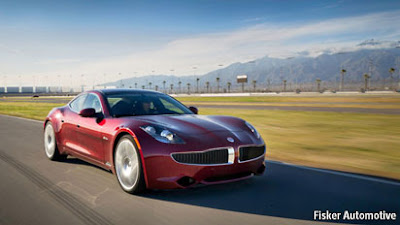This is the case when "who is writing" can be even more important than the subject itself. Fisker finally has made it and its first Fisker Karma - ultimate EV marketing machine - will be delivered to Leonardo di Caprio. This car will be turning heads on the streets and the names surrounding it will be making headlines. Now you can depart into the post carbon world in style and even without any range anxiety.
"Lithium Charge: Bottled Lightning: Superbatteries, Electric Cars, and the New Lithium Economy. Finally, we have the first book about the Lithium economy and Electric Cars - this Bull is still in its infancy now, just look around - how many Electric Cars can you see. For us it is like Gold and Silver in 2003 when nobody cared about it. This mega trend - Peak Oil multiplied by Inflation - will be even more powerful. Ugly Truth about diminishing Oil supply with constantly increasing demandwill make its way to the headlines again with higher Gas prices. Be prepared and tell the others - this time is coming and we can be ready for it. Time to act is now."
Economist:
Electric Cars
Karma chameleon.
THE first Fisker Karma, a luxury four-seater high-performance electric car, will be delivered to its first customer, one Leonardo di Caprio, on July 21st. The Hollywood film star will find that unlike other electric cars, the Karma has been designed to be driven like a conventional combustion-engined vehicle, but also with the ability to change its character and use electricity for a different driving style.
The Karma is being built by Fisker Automotive, a Californian company led by Henrik Fisker, who has designed cars for BMW, Ford and Aston Martin. Fully charged and with the car switched to what Fisker calls “stealth” mode, a 20kWh lithium-ion battery, hidden beneath the floor, gives it a range of about 80km (50 miles) and a top speed of 153kph. Like many hybrids, a petrol engine is installed to extend its range. Yet unlike those that use a range extender when the battery runs down, such as the Chevrolet Volt (Opel/Vauxhall Ampera in Europe), the Karma's two-litre turbocharged petrol engine, which sits under the bonnet in the front, never drives the wheels directly. Instead, it is perpetually connected to a generator which powers the car's two electric motors in the rear wheels.
As a result, besides its range-extending function, the petrol engine can improve the car's performance by delivering extra electricity whenever the driver flips on the vehicle's sport mode. This boosts acceleration and takes the top speed to 200kph. Switching between the different modes is done by one of a pair of paddles on the steering wheel. In a conventional modern sports car these are used to change gear. (As is often the case with such novelties, the paddles came from Formula 1.) But the Karma has no need of a gearbox, required by cars (hybrid or otherwise) whose petrol engines turn the wheels. That is because unlike petrol engines, which need to rev up before producing the torque necessary to budge a vehicle from a standstill or accelerate it quickly from a cruising speed, as in overtaking, electric motors provide full torque at the first touch of the accelerator pedal.
The other paddle, meanwhile, modulates the effect of regenerative braking. This uses the car's momentum when the accelerator pedal is not being pressed to generate electricity and feed it back into the battery. The fiercer the regenerative effect, the more power is fed to the battery, slowing the car more rapidly. This can be useful when going downhill, where the effect is similar to engine braking. Softer settings may be more comfortable in slow traffic.
The Karma, which costs around $100,000 in America, is being assembled for Fisker in Finland by Valmet, which produces performance cars for a number of manufacturers. Fisker hopes to sell up to 15,000 Karmas a year. A second model, called the Nina, is due to go on sale in 2013. This, says Mr Fisker, will be a four-door family saloon and will sell for about half the price of the Karma. The plan is for some 100,000 Ninas to be built every year at a former General Motors factory which Fisker has acquired in Delaware. The Nina will also be a hybrid fitted with a range-extending petrol engine. That configuration, reckons Mr Fisker, is the best way to relieve electric-car drivers of any symptoms of range anxiety."



No comments:
Post a Comment